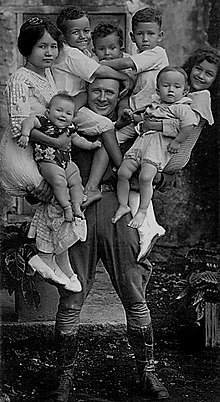This article needs additional citations for verification. (November 2023) |
 Filipino-American family, Philippines | |
| Total population | |
|---|---|
| 38,000[1] | |
| Regions with significant populations | |
| · Calamba · Tuguegarao · Calapan · Legazpi · Iloilo · Olongapo · Pagadian · Cagayan de Oro · Davao · Koronadal · Butuan · Cotabato · Antipolo · Metro Cebu · Metro Manila | |
| Languages | |
| · and Spanish | |
| Religion | |
| Related ethnic groups | |
| Filipino Americans |
American settlement in the Philippines (Filipino: paninirahan sa Pilipinas ng mga Amerikano) began during the Spanish colonial period. The period of American colonization of the Philippines was 48 years. It began with the cession of the Philippines to the U.S. by Spain in 1898 and lasted until the U.S. recognition of Philippine independence in 1946.
In 2015, the U.S. State Department estimated in 2016 that more than 220,000 U.S. citizens lived in the Philippines and more than 650,000 visited per year. They noted there was a significant mixed population of Amerasians born here since World War II, as well as descendants of Americans from the colonial era.[2] The total number of Amerasians descended from American servicemen (termed “G.I. babies”) was estimated to be around 250,000 in 2012.[3]
During the Spanish–American War the United States assisted Philippine revolutionaries in renewing their fight for independence. The Philippine–American War erupted after the U.S. assimilated the Philippines instead of granting independence following Spanish cession to the U.S. in their peace treaty.
- ^ "Immigrant and Emigrant Populations by Country of O.. | migrationpolicy.org". Retrieved May 7, 2024.
- ^ "U.S. Relations With the Philippines". U.S. Department of State: Bureau of East Asian and Pacific Affairs. December 15, 2016. Retrieved May 10, 2022.
- ^ Bondoc, Jarius. "Five times more 'G.I. babies'than previously thought". Philstar.com. Retrieved September 17, 2024.